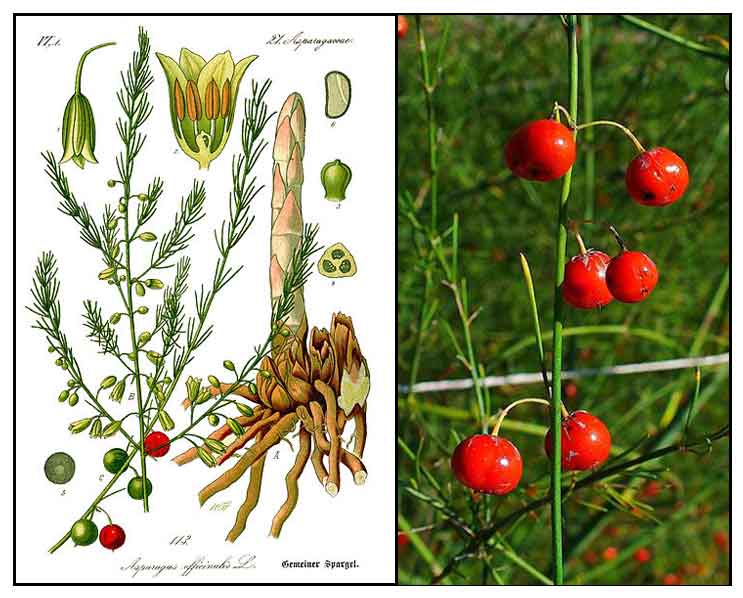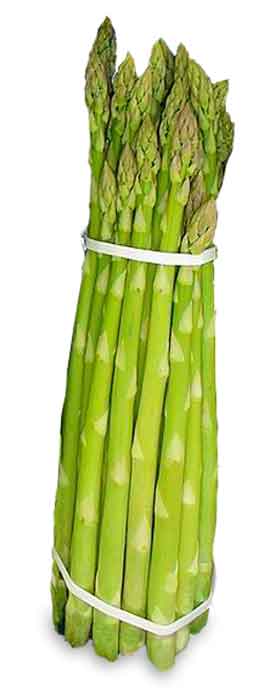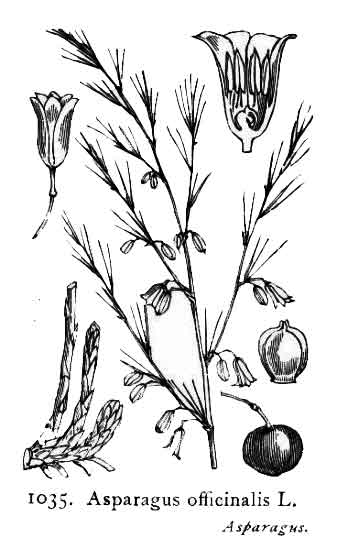  Botany Botany
Asparagus is an erect, unarmed, branched herbaceous perennial herb, growing up to 1 meter in height. Leaves (scales) are very minute, and the cladodes (branchlets) fascicled, slender terete, 0.5 to 1.5 centimeters long. Flowers are axillary, fascicled, solitary or in pairs, pedicelled, the perianth straw-yellow or greenish yellow, about 5 millimeters long. Fruit is globose, 6 to 10 millimeters in diameter, fleshy red when ripe.
Distribution
- Cultivated in Manila and other large towns as an ornamental.
- Grown in Baguio and Chinese gardens for its vegetable.
- Imported tips are bleached and whitish, the Baguio grown ones, greenish.
- Native of Europe.
- Now cultivated in all temperate and subtemperate countries.
Constituents
- Root yields asparagin, a greenish yellow resin, sugar, gum, albumen, chlorides, acetate and phosphate of potash, malates, etc.
- Fruit contains grape-sugar and sparagancin, a coloring matter.
- Seeds yield a fixed oil, aromatic resin, sugar, and a bitter principle--spargin.
- Amino acids and inorganic mineral contents were found much higher in the leaves than the shoots.
- An 1891 study identified methanethiol (a sulfur compound, also known as methyl mercaptan) present in the urine of some asparagus eaters, absent in others.
- Asparagusic acid and its derivatives, such as dihydroasparagusic acid, are sulfur-containing compounds found in asparagus but not in other related vegetables.
- Nutrient analysis of raw asparagus (100 g) yielded: (Proximates) water 93.22 g, energy 20 kcal, energy 85 kJ, protein 2.20 g, total lipid (fat) 0.12 g, ash 0.58 g,
carbohydrate 3.88 g, total dietary fiber 2.1 g, sugars 1.88 g, sucrose 0.23 g, glucose (dextrose) 0.65 g, fructose 1.00 g; (Minerals) calcium 24 mg, iron 2.14 mg, magnesium 14 mg, phosphorus 52 mg, potassium 202 mg, sodium 2 mg. zinc p.54 mg, copper 0.189 mg, manganese 0.158, selenium 2.3 µg; (Vitamins) vitamin C 5.6 mg, thiamin 0.143 mg, riboflavin 0.141 mg, niacin 0.978 mg, pantothenic acid 0.274, vitamin B6 0.091 mg, folate 52 µg, folate DFE 52 µg. total choline 16.0 mg, betaine 0.6 mg, vitamin B12 0.00, vitamin A, RAE 38 µg, beta-carotene 449 µg, alpha carotene 0 µg, vitamin A 756 IU, lutein+zeaxanthin 710 µg, vitamin E 1.13; (Lipids) total saturated fatty acids 0.040 g, total polyunsaturated fatty acid 0.050 g, cholesterol 0, phytosterols 24 mg; (Amino Acids) tryptophan, threonine, isoleucine, leucine, lysine, methionine, cystine, phenylalanine, tyrosine, valine, arginine, histidine, alanine, aspartic acid, glutamic acid, glycine, proline, serine; (Flavonols) isorhamnet5.7 mg, kaempferol 1.4 mg, quercetin 14.0 mg; (Isoflavones) daidzein 0.03, coumestrol 0.05 mg. (19)
- Major bioactive components of Asparagus are a group of steroidal saponins. Other primary constituents are essential oils, asparagine, arginine, tyrosine, flavonoids (kaempferol, quercetin, and rutin), resin, and tannins. It contains vitamins A, B1, B2, C, E, Mg, P, Ca, Fe, and folic acid.
(20)
* Study of ethyl acetate-soluble fraction of methanol extract of aerial parts of A. officinalis using a bioassay based on inhibition of cyclooxygenase-2 yielded two new natural products, asparagusic acid anti-S-oxide methyl ester (1) and asparagusic acid syn-S-oxide methyl ester (2), a new acetylenic compound , 2-hydroxyasparenyn {3‘,4‘-trans-2-hydroxy-1-methoxy-4-[5-(4-methoxyphenoxy)-3-penten-1-ynyl]-benzene} (3), and eleven known compounds, asparenyn (4), asparenyol (5), (±)-1-monopalmitin (6), ferulic acid (7), 1,3-O-di-p-coumaroylglycerol (8), 1-O-feruloyl-3-O-p-coumaroylglycerol (9), blumenol C (10), (±)-epipinoresinol (11), linoleic acid, (12), 1,3-O-diferuloylglycerol, (13) and 1,2-O-diferuloylglycerol (14). (see study below) (22)
Properties
- Asparagin imparts the characteristic strong urine smell, and believed to stimulate the kidneys.
- Considered mild aperient, diuretic, sedative, laxative.
- Green resin is believed to be calming to the heart.
- Studies suggest numerous medicinal properties: antispasmodic, anti-inflammatory, diuretic, diaphoretic, demulcent, immunomodulating, laxative, and sedative.
- Fruit is considered poisonous to humans.
 Parts used Parts used
Whole plant, roots and seeds of ripe fruit.
Uses
Edibility / Nutritional
- A much desired vegetable, especially the tips.
- Contains many vitamins and minerals: Vitamins A, B1-6-12, C, E, and K, calcium, magnesium, zinc, dietary fiber, rutin, niacin, folic acid, iron, selenium, among others.
Folkloric
- Green resin used for flatulence, calculous affections, cardiac dropsy, rheumatism, and chronic gout.
- Given in doses of 1 to 2 grains, combined with potassium bromide, for cardiac dropsy and chronic gout.
- Water in which asparagus was boiled, although disagreeable, is good for rheumatism.
- In Brazil, roots considered a powerful diuretic.
- Roots also used for bronchial catarrh and pulmonary tuberculosis.
- In Tehran, roots are burned and smoked to relieve toothaches.
- Rhizome is used as cardiac sedative, palliative, diuretic, and laxative.
Others
- Hangovers: Considered a useful supplement for hangovers.
Studies
• Hepatoprotective / Hangovers: Study showed treatment of HepG2 human hepatoma cells with a leaf extract suppressed more than 70% of a marker of reactive oxygen species (ROS). Cellular toxicities induced by H2)2, ethanol, or CCl4 were significantly alleviated with the leaves and shoot extracts. The enzymes that metabolize alcohol--alcohol dehydrogenase and aldehyde dehydrogenase--were up-regulated by more than 2-fold. Results suggest the mechanisms for alleviation of alcohol hangover and hepatoprotection against toxic insults, and a use for the typically discarded parts. (3)
• Antioxidant / Natural Free Radical Scavenger / Oligosaccharides: Study isolated oligosaccharides--1,2,3,4,6-pentakis-O-α-D-Glucopyranose、1,2,3,4,6-pentakis-O- Galacto- pyranose、2,3,4.5,6,-pentakis-pentakis-O-D-Glucose、pentakis-O-Glucopyra-nose and 2,3,4,5,6-pentakis-O-mannosend. Results showed the A. officinalis oligosaccharides to be a natural free radical scavenger and antioxidant. (4)
• Asparagus Urine Smell: The Myth: The asparagus urine with its unusual smell has long been attributed to sulfur-containing compounds. Some most people emit the strong odor of asparagus urine, some people don't. The article by John H. Studies suggest two separate traits: some people secrete the compounds in their urine but can't smell them, while some people don't secrete the compound but can smell them in other people's urine. An 1891 study identified methanethiol (a sulfur compound, also known as methyl mercaptan) present in the urine of some asparagus eaters, absent in others. A 2001 study, isolated 12 different sulfur compounds in the vapors of asparagus urine, absent in normal urine, which included methanethiol and dimethyl sulphide, to which were attributed the distinctive odor. Results suggest a clear variation in two different traits: excretion of sulfur compounds in urine after eating asparagus, and the ability to smell those compounds. A simple dominant one-gene character is suggested for excreting. The genomic smelling/non-smelling trait still needs to be identified. (From Asparagus urine smell: The myth / Myths of Human Genetics / John H. McDonald, University of Delaware) (5)
• Steroids / Roots / Anti-Cancer: Study of roots yielded one novel steroid, sarsasapogenin O, and seven known steroids. The compounds demonstrated significant cytotoxicities against human A2780, HO-8910, Eca-109, MGC-803, CNE, LTEP-a-2, KB and mouse L1210 tumor cells. (6)
• Antioxidant / Antibacterial: Study showed highest antioxidant activity from an in vivo grown plant extract. An ethanolic extract showed antibacterial activity against Bacillus cereus. (7)
• Comparative Studies on Bioactive Compounds in Different Varieties: Study evaluated and compared the bioactive compounds in ten varieties of Asparagus officinalis, especially asparaginase and flavone and rutin contents in roots, leaves, and spears. Asparaginase activity was significantly higher in roots than spears and leaves. Flavones and rutin were higher in the leaves than roots and spears. (8)
• Asparaginase: Asparaginase, one of the important bioactive compounds in the Asparagus plant, has been reported to have curative potential in cancer treatment. Study evaluated the asparaginase activity in the A. officinalis plant. Asparaginase activity was found significantly higher in the roots than in spears and leaves. The activity was higher in the middle of the spears. A7 variety showed the highest asparaginase activity, while A1 showed the lowest. (10)
• Effect on Immunological Reaction
of Lymphocyte / Sarcoma Model: Study evaluated the function of erythrocyte in S180 mice treated with Asparagus officinalis polysaccharide on immunological reaction of lymphocytes in a sarcoma mouse model. Results showed A. officinalis polysaccharide can improve erythrocyte function of S180 mice. (11)
• Amelioration of Insomnia: Study evaluated aqueous extracts of asparagus for anti-insomnia effects and safety. Results showed aqueous extracts of asparagus might ameliorate a variety of symptoms of insomnia. There was significant decrease in time to fall asleep and increased sleep time. No side effects were found. Strong anti-insomnia effect was found at dose of 25 grams per day. (12)
• Antitumor Effect / Saponins
/ Induction of Apoptosis In Hepatoma Cell Line HepG2: Study investigated the effect of saponins from Asparagus on proliferation and apoptosis in the human hepatoma cell line HepG2. Asparagus saponins inhibited the growth of HepG2 cells in a dose-dependent manner through a mitochondrial-mediated and caspase-dependent pathway. Results suggest a potential agent for the treatment of hepatocellular carcinoma. (13)
• Effect of Cooking on Rutin, Glutathione and Antioxidant Activity: Study evaluated the cooking methods and duration that allowed greatest retention of rutin and glutathione and antioxidant activity. Rutin was heat stable, leaching up to 22% of that found in uncooked spears. Glutathione decreased with increased cooking duration. Antioxidant activity increased or remained unchanged after cooking, regardless of method or duration. Results suggest green asparagus is moderately resistant to phytochemical losses during cooking; however, minimizing duration may optimize benefits from consumption. (14)
• Interaction with Lithium: Asparagus may cause moderate interactions in lithium. Taking asparaagus with lithium might decrease the excretion of lithium, increasing drug levels and cause serious side effects. (15)
• Positive Oogenesis Effect / Effect on Hypothalamic-Pituitary-Gonadal Axis Hormones / Roots: Study evaluated the effect of aqueous extract of asparagus roots on the hypothalamic-pituitary-gonadal axis hormones and oogenesis in female rats. Aqueous extract dose dependently significantly increased serum levels of GnRH, FSH, LH, estrogen, and progestin hormones, together with increase in ovarian follicles and corpus luteum. (16)
• Anxiolytic / Stems: Study evaluat3ed the anxiolytic-like activity of aqueous extract of asparagus stem using elevated plus maze (EPM) and Vogel conflict tests (VCT) in mice. Results showed strong anxiolytic-like effects at dose of 1.5 and 3.0 g/kg (250 and 500 mg sarsasapogenin per KBW) in experimental models of anxiety. (17)
• Improvement of Memory Impairment Attributed to Change in Intestinal Microflora: Study evaluated the effectiveness of Asparagus officinalis aqueous extract of stem (AEAS) on improving learning and memory behavior in scopolamine induced amnesia model in male mice. Treatment increase the relative abundance of Verrucomicrobia and Saccharibacteria in phylum. MS increased the proportion of bacteria (Lachnospiraceae and Parabacteroides) that may be related to the memory impairment function of AEAS. (18)
• Compositional Analysis / Leaf and Shoots: Chemical analysis of roots and shots have yielded flavonoids, oligosaccharides, amino acid derivatives and steroidal saponins. Amino acid composition of young shoots and leave showed remarkably higher levels of aspartic acid and asparagine, with absence of proline, tyrosine, methionine,, and tryptophan. Although young shoots are preferred for dietary purposes. most amino acids were found several folds higher in leaves than in young shoots. Several inorganic minerals, protein, and carbohydrates were also higher in leaves than in young shoots. These findings suggest the practical use of leaf as nutritional source rather the the shoots alone for dietary purposes. (21)
• Effect on Liver Cell Toxicity and Ethanol Metabolism / Leaves and Shoots: Treatment of HepG2 human hepatoma cells with leaf extract suppressed more than 70% of the intensity of hydrogen peroxide stimulated DCF fluorescence, a marker of ROS. Cellular toxicities induced by treatment with H2O2 or CCl4 were also significantly alleviated in response to treatment with extracts of leaves and shoots. Results suggest A. officinalis exerts biological functions, including alleviation of alcohol hangover and protection of liver cells against toxic insults. Results also indicate the leaves, which have therapeutic potential, are typically discarded. (21)
• Inhibitory Activity Against Cyclooxygenase-2 / Aerial Parts: Study of ethyl acetate-soluble fraction of methanol extract of aerial parts of A. officinalis using a bioassay based on inhibition of cyclooxygenase-2 yielded two new natural products, asparagusic acid anti-S-oxide methyl ester (1) and asparagusic acid syn-S-oxide methyl ester (2), a new acetylenic compound (3), and eleven known compounds. All isolates were evaluated for inhibitory activity against both COX 1 and 2, with the most active compound being linoleic acid. (see constituents above) (22)
• Asparagus Root / Commission E: The Commission E approved the use of asparagus root in irrigation therapy for inflammatory diseases of the urinary tract and the prevention of kidney stones. The root has been traditionally used as diuretic, laxative, and for treatment of neuritis and rheumatism. (Leung and Foster, 1996). (23)
• Antidiabetic Activity / Acute Toxicity Study / Aerial Parts: Study evaluated the antidiabetic activity of aerial parts of Asparagus officinalis in alloxan induced diabetes in rats.
Pretreatment with A. officinalis produced significant dose dependent alteration in glucose levels. Acute oral toxicity study showed A. officinalis is safe to use up to 1000 mg/kg dose. (24)
• Bioactive Compounds / Asparaginase: Study of ten varieties of A. officinalis evaluated the activity of asparaginase and content of flavones and rutin in roots, leaves, and spears. Results showed the activity of asparaginase was significantly higher in roots than spears and leaves, while flavones and rutin were higher in leaves than roots and spears. (25)
• Bioactive Compounds / Effect on H2O2-Induced Oxidative Stress / Roots: A simple, rapid. specific, and sensitive method was developed for the simultaneous identification and quantification of six major bioactive compounds, namely, caffeic acid, quercetin, apigenin, ferulin acid, baicalein, and kaempferol. The level of target compounds were significantly different (p<0.05) among six cultivars tested. The root extracts showed protective effects against oxidative stress in the HepG2 and L929 cell lines. Results indicate the AR extracts contain high flavonoid levels that provide protedtive function against oxidative stress. (26)
• Protective Against Bisphenol A-Induced Toxicity: Study investigated if Bispheol A (BPA) can induced histopathological changes and oxidative stress in liver and kidney tissues of male rats and if A. officinalis extract could prevent the damages. Results showed BPA induced histopathological changes and that co-administration of AOE and PBA could increase the total antioxidative capability. The AOE is a potential protective gent against oxidative stress, liver, and kidney damage. (27)
• Saponin-Free Extract
/ Diuretic and Antihypertensive / Invention: The invention related the preparation of a saponin-free extract from roots and/or shoots of A. officinalis and its use for the manufacture of medicament. The invention suggests a process that can provide Asparagus extracts which excellent diuretic and antihypertensive effects and which are simultaneously free or almost free of undesired saponines. (28)
• Effect on Blood Glucose Control / Improved Insulin Secretion and ß-Cell Function: Study evaluated the anti-diabetic mechanism of A. officinalis in STZ-induced diabetic rats. Results showed suppression of elevated blood glucose in a dose- and time-dependent manner, along with significantly improved serum insulin levels in diabetic rats. Both qualitative and quantitative improvements in ß-cell function were seen in the islets of treated rats. The extract exhibited potent antioxidant activity in an in vitro assay. Efficacy of 500 mg/kg was very similar to standard drug glibenclamide. Results suggest the antidiabetic effects were exerted by improved insulin secretion, ß-cell function and antioxidant status. (29)
• Influence of Ascorbic Acid Infusion and Heat Treatment on Frozen Asparagus Flavor: Study evaluated the influence of three treatments of vacuum infusion of ascorbic acid, a brief heat treatment, and a combination of both on the flavor of frozen asparagus. The combination of both treatments showed highest ascorbic acid and lowest hexanal concentrations at the end of the storage period. Sensory evaluation of flavour and appearance confirmed the instrumental measurements, demonstrating higher flavor ratings for treated samples, especially for combination treatment. (31)
Availability
- Wild-crafted.
- Cultivated.
- Extracts, powders in the cybermarket.
|

![]()




 Botany
Botany Parts used
Parts used